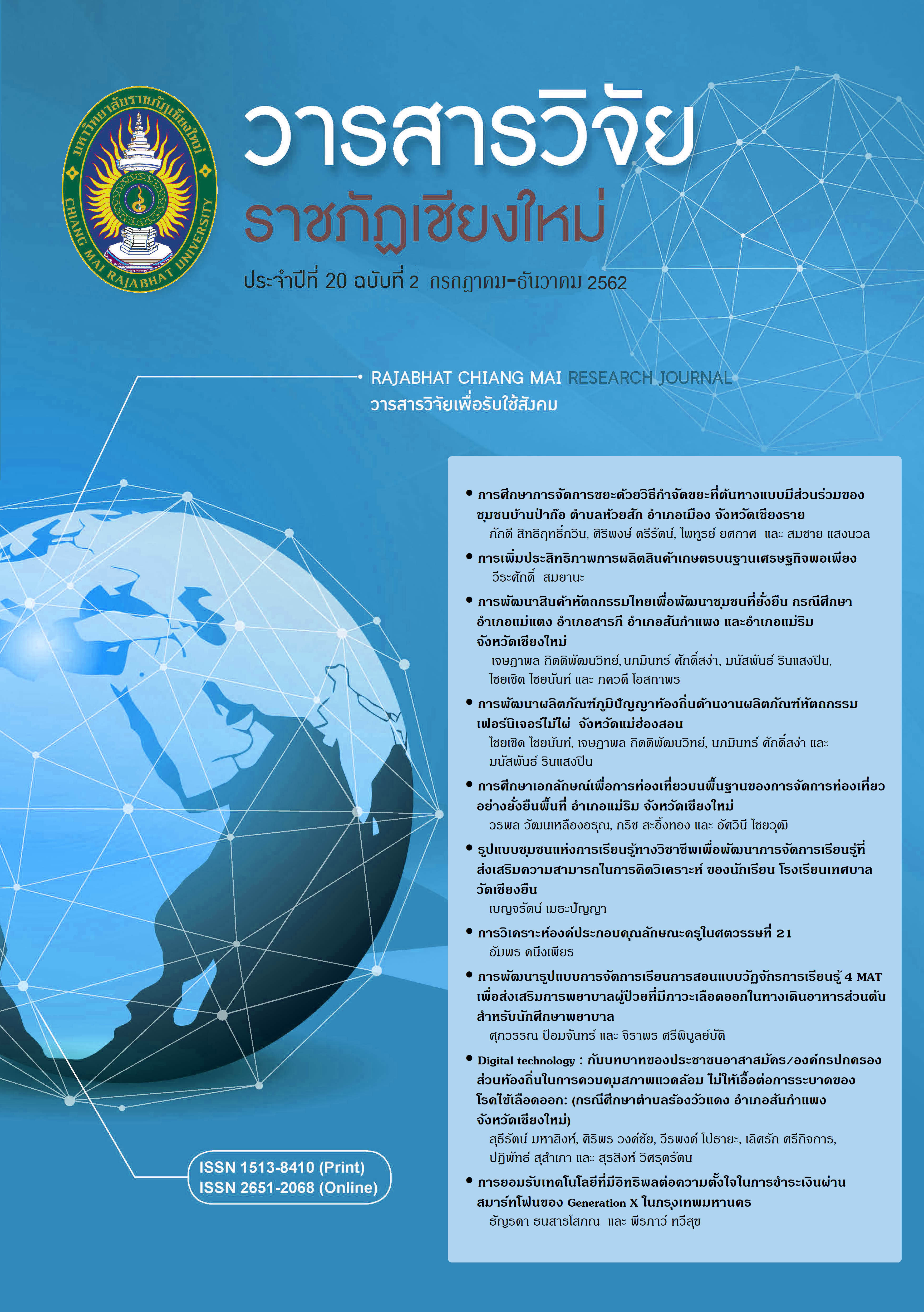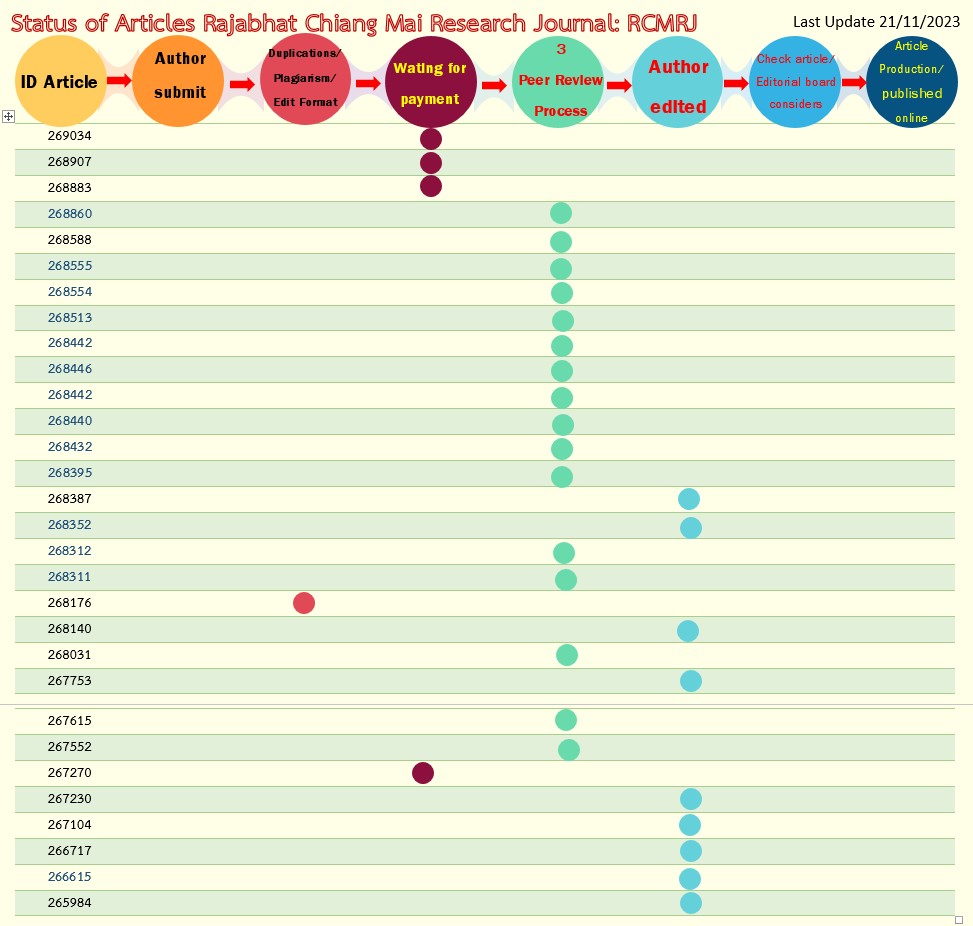Development of Thai Handicrafts for Sustainable Community Development Case Study at Mae Tang, Saraphi, Sankampaeng and Mae Rim, Chiang Mai
DOI:
https://doi.org/10.14456/rcmrj.2019.160088Keywords:
Development of Thai handicrafts, Sustainable communitiesAbstract
The development of Thai handicraft to thrive a sustainability in community; case study, four sub-district area in Chiang Mai Province including Mea Tang, Saraphi, Sankampeang, and Mea Rim aims to 1) desire and develop the handicraft products in Chiang Mai and 2) evaluate the satisfaction of the developed handicraft products in four sub-district area. This research had collected many samples of the old style product and their making process under the design knowledge. Then, the research had analyzed and developed products to meet the need of samples group and customers. The research had brought out the outstanding points of products from four groups to develop the new style products and evaluate the satisfaction. From 80 people, most of them, 25 people which equal 31.25%, told that the beauty, color, and tracery of the products are the most important issue. After the process, 248 samples group had evaluated the new handicraft products which had been developed under this research.
The research found that in Mea Tang sub-district, the products from Baan Nong Tong community enterprise group had got a high level of satisfaction (mean =4.36, standard deviation =0.15) in Mae Rim sub-district, the products from Pang Luang community enterprise group had got a highest level of satisfaction (mean= 4.50, standard deviation = 0.17)) in Sarapi sub-district, the products from Pa Pong Luang community enterprise group had got a high level of satisfaction (mean = 4.21, standard deviation = 0.13) in San Kam Peang sub-district, the products from San Kam Peang community enterprise group had got a highest level of satisfaction (mean =4.68, standard deviation = 0.09)
References
ธีระชัย สุขสด. (2544). การออกแบบผลิตภัณฑ์อุตสาหกรรม. กรุงเทพฯ: โอ.เอส.พริ้นติ้ง เฮาส์.
นวลน้อย บุณวงค์.(2539). หลักการออกแบบ. กรุงเทพฯ: จุฬาลงกรณ์มหาวิทยาลัย.
มนัสพันธ์ รินแสงปิน, เจษฎาพล กิตติพัฒนวิทย์, นภมินทร์ ศักดิ์สง่า, และไชยเชิด ไชยนันท์. (2560). การศึกษาข้อมูลด้านศิลปหัตถกรรมของชนเผ่าต่าง ๆ เพื่อการพัฒนาผลิตภัณฑ์งานจักสานเพื่อการพาณิช อำเภอแม่สะเรียง จังหวัดแม่ฮ่องสอน. วารสารวิจัยราชภัฏเชียงใหม่, 18(2), 50-58.
วิบูลย์ ลี้สุวรรณ. (2539). ศิลปหัตถกรรมพื้นบ้าน. พิมพ์ครั้งที่ 4. กรุงเทพฯ: บริษัทต้นอ้อ แกรมมี่จำกัด.
ศรีสุดา ลีลาสุวัฒน์ และคณะ. (2558). แนวทางการพัฒนาการตลาด OTOP สู่สากล อำเภอสามพราน จังหวัดนครปฐม. มหาวิทยาลัยเทคโนโลยีราชมงคลรัตนโกสินทร์.
Downloads
Published
How to Cite
Issue
Section
License
1. Articles, information, content, images, etc. that are published in "Chiang Mai Rajabhat Research Journal" is the copyright of Chiang Mai Rajabhat Research Journal. Chiang Mai Rajabhat University. If any person or organization wants to distribute all or any part of it or do any action Must have written permission from the Chiang Mai Rajabhat Research Journal, Chiang Mai Rajabhat University.
2. Content of articles appearing in the journal is the responsibility of the author of the article. The journal editor is not required to agree or take any responsibility.














